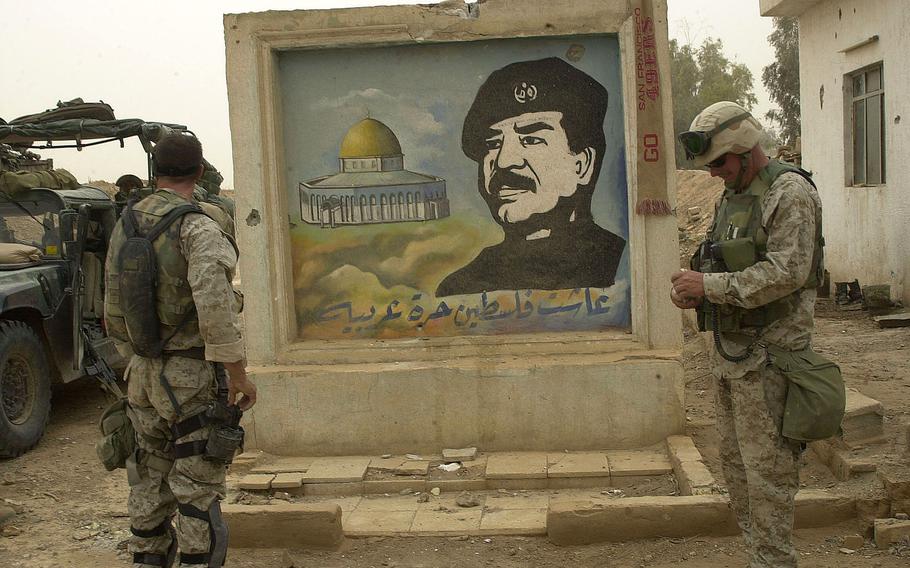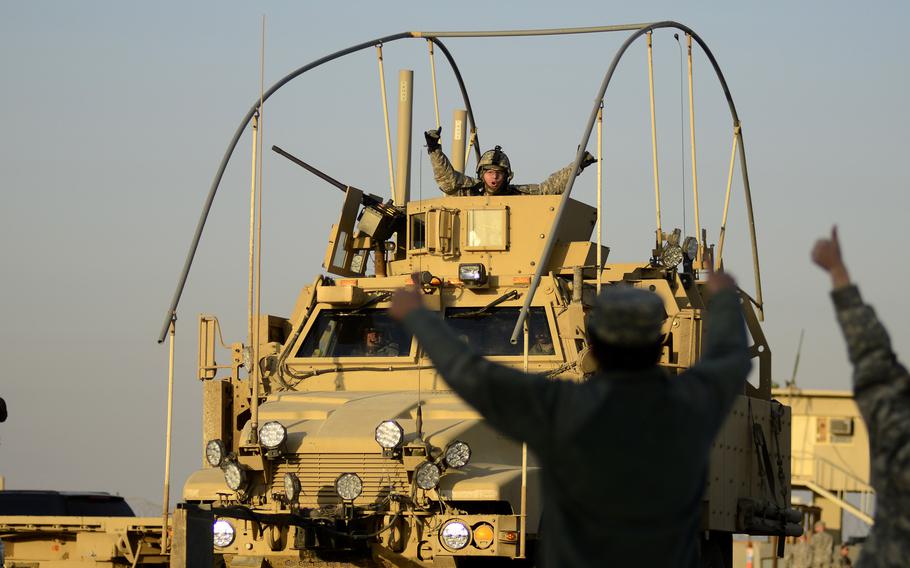
Marines stand at the gate of a suspected terrorist training camp outside of Baghdad, Iraq, with a mural of Saddam Hussein, April 7, 2003. Twenty years later, Iran maintains considerable influence over Iraq, and the U.S. still has troops in the country to prevent an Islamic State group resurgence. (Stars and Stripes)
Iraqis enjoyed a little dark humor during last year’s World Cup match in Qatar between the Iranian and U.S. teams, representing two of the geopolitical rivals that now hold sway in their country.
“The joke was this is the first time Iran and America are playing outside Iraq,” recalled Ghaith Abdul-Ahad, a journalist from Baghdad who has reported extensively on his homeland since the U.S. invasion 20 years ago.
Iran, which had fought a protracted and bloody war against Iraq, is now deeply enmeshed in its neighbor’s politics and economy, analysts and Iraqi journalists said, in the days leading up to the 20th anniversary of the U.S. invasion that toppled Iraqi President Saddam Hussein.
Saddam’s ouster in 2003 removed a brutal dictator but also provided an opening for Iran’s leaders.
“It’s fair to say that Iran is in many ways in control of the Iraqi politics,” Omar Mohammed, a historian from Mosul, said at the recent 2023 Global Security Forum in Doha, Qatar.
More than a dozen Iraqi political parties and paramilitary groups are tied to Iran, some of which pledge allegiance to Iranian supreme leader Ayatollah Ali Khamenei, a 2022 brief by the Council on Foreign Relations said.
Iran’s political sway is such that the democratic system the U.S. imposed resulted in a vote in 2020 to expel American soldiers. An agreement in 2021 following that non-binding resolution ended the formal U.S. combat mission but kept 2,500 troops in Iraq.
Mistakes and policy flip-flopping by the U.S. over the past 20 years have led many Iraqi leaders to decide that turning to their meddling neighbor is a more reliable option, said Jonathan Lord, senior fellow at the Center for a New American Security, a Washington-based think tank.
However, many Iraqis have protested their leaders’ ties to Iran.
“The Iraqi people are wise to Iran’s meddling,” Lord said.
In 2019, angry demonstrators denounced foreign interference with slogans such as “no to America, no to Iran” during widespread anti-government unrest, according to an Al Jazeera report from the time.
Other analysts pointed to moments when Tehran capitalized on Washington’s mistakes.
The U.S. lacked a clear plan for the days after the invasion and Iran swiftly took advantage of it, Joseph Votel, a retired general who helmed U.S. Central Command from 2016 to 2019, said in a recent interview.
American policies disproportionately removed Iraqi Sunnis, who represented much of Saddam’s Baath party, from the government and the military. Iraq became dominated by political and religious leaders from its Shiite majority.
“The introduction of a (Shiite)-led government in the wake of Saddam’s Sunni government clearly provided opportunities for Iran, which they have exploited,” Votel said.
When Iraqis launched an insurgency against occupying American troops, Iran began supplying weapons to militant groups, said Farzin Nadimi, an associate fellow at the Washington Institute and an Iran analyst.
“Iran had simple goals in Iraq: to create and maintain a foothold in Iraq by supporting friendly Shiite elements in and out of the government, and to undermine the U.S. presence in Iraq in any way possible,” Nadimi said.
Some 603 U.S. troops in Iraq are believed to have been killed by Iranian-backed militias, about a sixth of total casualties, the Pentagon said in 2019.
With the American public weary of the war, the U.S. committed to leaving Iraq by 2011, prompting Baghdad to drift closer to Tehran, said Katherine Zimmerman, a fellow at the Washington-based American Enterprise Institute.
“The unwillingness of the U.S. to remain invested in Iraq’s future after the end of the Iraq war helped tip the scales in Tehran’s favor as Iranian-backed actors’ influence grew,” Zimmerman said.
American troops left behind a weak and corrupt Iraqi military, which melted in the face of an Islamic State group offensive that swept the country in 2014.
ISIS conquered about half of Syria and 40% of Iraq but eventually lost its territorial acquisitions following battles against a broad U.S.-backed coalition.
Shiite militias formed to fight ISIS and have continued to hold sway in Iraq ever since. Many Iraqis attribute the victory against the Islamic State to Iran and its militias, analysts said.
Despite the formal end of the U.S. combat mission in Iraq in 2021, about 2,500 U.S. service members remain to prevent an ISIS resurgence, Central Command said in an email Wednesday.

U.S. soldiers cheer for each other as the last U.S. military convoy to exit Iraq heads across the Kuwait border at the Khabari crossing, Dec. 18, 2011. About 2,500 U.S. troops are in Iraq as of 2023 to help prevent a resurgence of the Islamic State group. (Stars and Stripes)
Iraqi troops trained by these American forces have conducted their own raids against ISIS, according to CENTCOM.
But U.S. troops still in Iraq face another danger: rocket fire and drone attacks from Iranian-backed militias.
One such attack in 2021 killed a civilian contractor and injured a U.S. service member, leading to retaliatory American airstrikes.
Iran directly attacked the American military contingent at al Asad Air Base in 2020 after a U.S. drone strike killed Qasem Soleimani, an Iranian general operating in Baghdad. The ballistic missile attack by Tehran injured 100 U.S. service members.
If tensions rise between Iran and the U.S. and its allies in the Middle East, troops in Iraq will be at risk, said Barbara Slavin, a distinguished fellow at the Stimson Center in Washington.
Her assessment of the U.S. invasion of Iraq and the subsequent war mirrors the Army’s own history of the conflict, a voluminous report released in 2019 that declared Iran the only winner.
“It was supposed to solve our problems in the Middle East, and it didn’t,” Slavin said. “By getting rid of one bad actor, we emboldened another bad actor: Iran.”